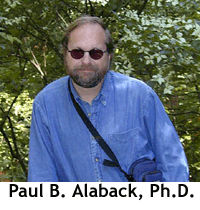Paul Alaback
From an “Ecologist Directory” maintained by the ESA Education Office about 2004-2011. Profile circa 2004-05.
Current: Professor Emeritus of Forest Ecology, University of Montana.
1980 Ph.D. Oregon State University, Corvallis, OR. Forest Science (forest ecology)
1976 B.S. Botany, B.S. Forest Science. University of Washington, Seattle, WA.
Ecologist Profile

I became interested in ecology in high school. I volunteered with local Audubon society chapters where I developed an early interest in natural history, then became involved with a explorer scout troup, led by a Loyola Univ. biologist, Dr. Hunter Mermall. We worked on monitoring streams around Chicago documenting water quality violations, and filing them with the county, resulting in many improvements to these streams. This early exposure to the excitement of learning something new, and seeing how carefully gathered scientific information could help in conservation efforts made it clear to me that this is what I wanted to devote my life to. I was the recipient of the national Izaak Walton award when I was a senior, resulting in a summer job for the Forest Service in a remote part of northern Idaho. Ranger district foresters showed me the fascinating complexity of forests and forestry, and in particular encouraged me in my new found interest in plant ecology. Before I even started my freshman year of college I was ready to devote myself to becoming a USFS forest ecologist, with a particular fascination with the wet, remote and wild forests of the Pacific Northwest coast.
I learned about ecological careers first through reading conservation periodicals and seeing public television documentaries, then through opportunities to work with ecologists and natural resource professionals in summer jobs with the Forest Service, through volunteer work with conservation NGO’s, and by attending ESA meetings. I am now the ecologist for the forestry department at the University of Montana. I teach forest ecology, landscape ecology, wilderness ecology, and do field-based classes for the wilderness and civilization program. I also continue my research on temperate rainforests as well as work with both undergraduate and graduate students in a wide variety of ecology and conservation projects.
My route to becoming an ecologist was surprisingly linear. Since I knew I wanted to become a forest ecologist working on the Pacific coast I decided to get a double major in forestry and botany at the University of Washington, where temperate rainforests were close by. I worked every summer for the Forest Service, which always further stimulated this passion. My big break occurred in the spring of 1974, when I was a junior. I finally got a summer job in Southeast Alaska. It was love at first sight. My supervisors encouraged me in my volunteer floristic studies (in addition to my forestry job), and gave me the opportunity to spend a week working for the research lab. The director of the lab, Don Schmiege took an interest in me and by the time I graduated, two years later they gave me the opportunity to apply for a research grant. I skipped a masters degree and got a PhD in forest ecology 4 years later. My advisor Dr. Jerry Franklin not only provided great technical advice on how to do good science, but showed me the excitement of taking that science and using it to promote change in federal policy, and even general understanding of the public.
I did a post-doc with Oregon State for 5 years with the NSF LTER program then finally became the first USFS forest ecologist based in SE Alaska. My research documenting the long-term effects of clearcutting on forest structure and biodiversity, the ecological characteristics of temperate rainforests both in Alaska and elsewhere in the world, and my work with the media to make this information accessible to politicians and general public, helped to build a consensus to protect nearly a third of these forests before I left the USFS. I then took a faculty position at the University of Montana where my research has broadened to include landscape ecology and fire-dependent grassland and forest ecosystems, and a more explicit consideration of the broader social and cultural context for conservation. My greatest challenges are being able to ask the right questions despite the daunting nature of the complexity of forest ecosystems and how to best communicate both understanding and appreciation of the natural world.
It’s important to follow your passions. I am glad I ignored much well-intended practical advise that suggested field ecology was not a “practical” career. Its also important to keep a broad perspective: interact with as broad a range of colleagues as you can – it is in looking at things across conventional norms that true innovation often occurs.